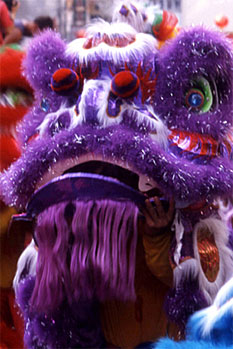

One World
Nations Online
All Countries in the World
 |
 One World Nations Online All Countries in the World |
| Home |
||
___ Lion DanceLion dance (simplified Chinese: 舞狮; traditional Chinese: 舞獅; pinyin: wǔshī). Along with the noise of fire crackers, the Lion Dance can be observed as a masked dance performance. |
||
Lion Dance Lion dances take place during the first few days of the Chinese New Year. A Lion Dance starts and ends at a temple, where the lions will pay respect not only to the temple and its deities, but to the ancestral hall as well (see: Ancestor Worship). The dramatic climax of the Lion Dance is the "Cai Qing" or 'Picking the Green'. The green here refers to vegetable leaves which are tied to a piece of string which also has a red packet attached containing money. The string is hung above the door of the business, shop (or home), and the lion 'eats' both, the leaves and the red packet. Lying on the floor the leaves are 'chewed' by the lion while the musicians play a dramatic rolling crescendo. The lull is broken as the lion explodes back into activity, spitting out the leaves. This is a symbolic act of blessing by the lion, with the spitting out of the leaves signifying that there will be an abundance of everything in the coming year. Apart from the lion, the performers are accompanied by a fan bearer, the funny, smiling person or ‘uncle’, the latter being the God of Smiles. While fascinating, entertaining and richly this ritual demonstrates how one should approach the ineffable - with good humour and dexterity. There are various styles of lions and lion dances, though the biggest distinction is the Northern and the Southern. The Northern lion dance was used for entertaining the Imperial Court, the lions showed more of a lion’s flowing mane, the appearance similar of a fu lion, a Pekinese dog. The appearance of the lion and the color of the fur has a symbolism to it as well. The Five Element’s theory, the symbolism of colors, the bagua and colors associated with Feng Shui are one base for ‘interpreting’ the color of the lion’s fur. Traditionally there might have been different interpretations, while folk tales will have added their influences. |
 Head of a Lion Dance costume, China Town, Bangkok Photo © Valeska Gehrmann |
|
Country information: China | Bhutan | Hong Kong | India | Japan | Korea | Laos | Malaysia | Mongolia | Nepal | Singapore | Taiwan | Tibet | Thailand | Vietnam More Countries in Asia Map of Southeast Asia Back to the index of Chinese Customs and Traditions Glossary |
Bookmark/share this page
|
|
One World - Nations Online .:. let's care for this planet To the mind that is still, the whole universe surrenders. 老子 |
| Site Map | Information Sources | Advertise with OWNO | Disclaimer: Privacy Policy, etc. | Contact: [email protected] | Copyright © 1998-2016 :: nationsonline.org |